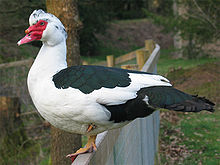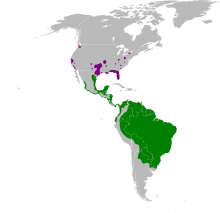| Muscovy duck | |
|---|---|

| |
| Scientific classification | |
| Domain: | Eukaryota |
| Kingdom: | Animalia |
| Phylum: | Chordata |
| Class: | Aves |
| Order: | Anseriformes |
| Family: | Anatidae |
| Genus: | Cairina Fleming, 1822 |
| Species: | C. moschata
|
| Binomial name | |
| Cairina moschata (Linnaeus, 1758)
| |
| Subspecies | |
| |

| |
Natural range Introduced feral populations
| |
| Synonyms | |
|
Anas moschata Linnaeus, 1758 | |
The Muscovy duck (Cairina moschata) is a duck native to the Americas, from the Rio Grande Valley of Texas and Mexico south to Argentina and Uruguay. Feral Muscovy ducks are found in New Zealand, Australia, and in Central and Eastern Europe. Small wild and feral breeding populations have also established themselves in the United States, particularly in Florida, Louisiana, Massachusetts, the Big Island of Hawaii, as well as in many other parts of North America, including southern Canada.[3][4]
It is a large duck, with the males about 76 cm (30 in) long, and weighing up to 7 kg (15 lb). Females are noticeably smaller, and only grow to 3 kg (6.6 lb), roughly half the males' size. The bird is predominantly black and white, with the back feathers being iridescent and glossy in males, while the females are more drab. The amount of white on the neck and head is variable, as well as the bill, which can be yellow, pink, black, or any mixture of these colors. It may have white patches or bars on the wings, which become more noticeable during flight. Both sexes have pink or red wattles around the bill, those of the male being larger and more brightly colored.[5][6]
Although the Muscovy duck is a tropical bird, it adapts well to cooler climates, thriving in weather as cold as −12 °C (10 °F) and able to survive even colder conditions.[7][8] In general, Barbary duck is the term used for C. moschata in a culinary context.
The domestic subspecies, Cairina moschata domestica, is commonly known in Spanish as the pato criollo. They have been bred since pre-Columbian times by Native Americans and are heavier and less able to fly long distances than the wild subspecies. Their plumage color is also more variable. Other names for the domestic breed in Spanish are pato casero ("household duck") and pato mudo ("mute duck").
- ^ BirdLife International (2018). "Cairina moschata". IUCN Red List of Threatened Species. 2018: e.T22680061A131911211. doi:10.2305/IUCN.UK.2018-2.RLTS.T22680061A131911211.en. Retrieved 13 November 2021.
- ^ Donkin 1988.
- ^ "Muscovy - an overview". Sciencedirect.com. Retrieved 2021-06-17.
- ^ "Poultry Breeds - Muscovy Duck — Breeds of Livestock, Department of Animal Science". afs.okstate.edu. Retrieved 2021-06-17.
- ^ "Muscovy Duck". ebird.org. Retrieved 2021-06-17.
- ^ "Muscovy Duck". txtbba.tamu.edu. Retrieved 2021-06-17.
- ^ Holderread 2001, p. 17
- ^ Cite error: The named reference
nis.gsmfc.orgwas invoked but never defined (see the help page).
